Which Is the Best Telescope for Astrophotography This Year? We Have 9 Picks for You!
October 16th, 2019
by Barbara Hogg
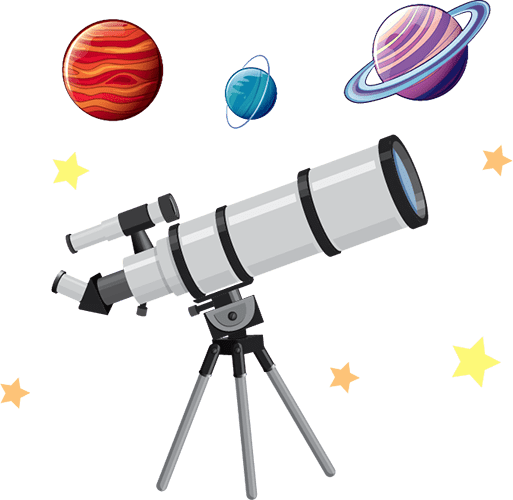
Astrophotography is a serious hobby that requires a lot of time and financial investment. It compels you to know about astronomy and photography – two complicated subjects on their own. To reach such high goals, you need the best telescope for astrophotography on the market!
Exploring the sky with a telescope is the closest that most of us are going to get to being in outer space. As you discover the great beyond, you may want to capture pictures of distant galaxies and stars to share with the world. To do that, you need the right equipment. We have listed the 9 best telescopes for astrophotography and have included a buyer’s guide at the end so that you know exactly how to buy your gear.
If you are new to astronomy, you should check out our guides on Optical Concepts Explained: How do Telescopes Work? and 9 Best Telescopes for Beginners. These tutorials will give you a clearer picture of how such instruments work and what you should look for when you buy your first telescope.
There are a few things that you can try to get the flavor for astrophotography without any serious commitment. You can start by taking pictures of the moon and nearby stars with your smartphone or camera if you have one. There are plenty of accessories such as different lenses and tripods that you can also buy. However, until you get there, let’s see each best telescope for astrophotography on the market today!
| Product Name | Type | Aperture | Magnification | Price |
|---|---|---|---|---|
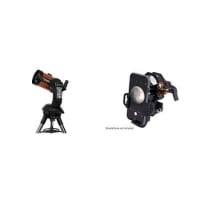 Celestron NexStar 5 SE Astrophotography Telescope
Celestron NexStar 5 SE Astrophotography Telescope
|
Schmidt-Cassegrain | 5 inches | 50 X | Check Latest Price |
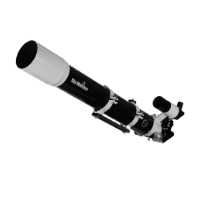 Sky-Watcher ProED 100mm Astrophotography Telescope
Sky-Watcher ProED 100mm Astrophotography Telescope
|
Refractor | 3.9 inches | 45 X & 180 X | Check Latest Price |
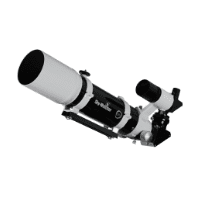 Sky-Watcher ProED 80mm Astrophotography Telescope
Sky-Watcher ProED 80mm Astrophotography Telescope
|
Refractor | 3.2 inches | 30 X & 120 X | Check Latest Price |
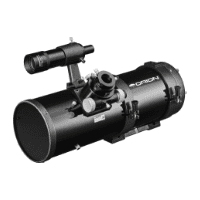 Orion Astrograph Astrophotography Telescope
Orion Astrograph Astrophotography Telescope
|
Reflector | 6 inches | 177 X | Check Latest Price |
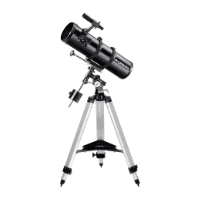 Orion SpaceProbe Astrophotography Telescope
Orion SpaceProbe Astrophotography Telescope
|
Reflector | 5.1 inches | 26 X & 65 X | Check Latest Price |
1 Celestron NexStar 5 SE Telescope for Astrophotography
If you are in the market for a top-quality telescope with plenty of tech specs and pro features, then this might be the one for you. The first entry on our list of best telescopes for astrophotography allows you to capture stunning views of deep space objects with crystal clear optics. This Celestron comes with the Nex YZ smartphone adapter that securely attaches your phone to the eyepiece.
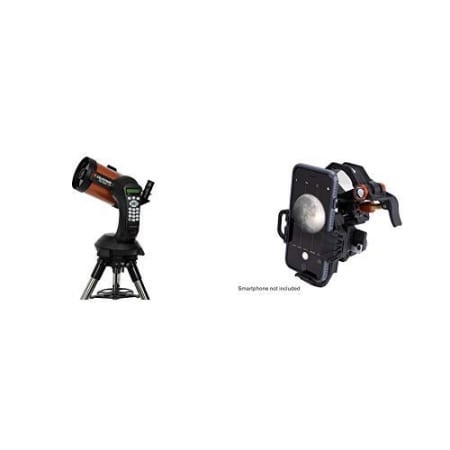
| BEST FOR Overall Quality |
|
| Type | Schmidt-Cassegrain |
|---|---|
| Item Weight | 15 pounds |
| Item Size | 32 x 26 x 13 inches |
| What You See | Moon, planetary bodies, rings of Saturn, clouds of Jupiter, star clusters, Hercules Globular Cluster, Orion Nebula, distant galaxies, etc. |
| Magnification | 50 X |
| Aperture | 5 inches / 130 mm |
| Mount | Motorized equatorial |
| Special Features | Nex YZ smartphone connector, automated GoTo mount, single fork arm mount Steel tripod, star diagonal, focal length 1250mm, focal ratio f/10 |
| Warranty | 2 years |
Why choose the Celestron NexStar 5 SE Telescope for Astrophotography?
As you know already, the Celestron family has some of the best telescopes on the market. There is no wonder, thus, that the best telescope for astrophotography on our list is an “orange tube” classic Celestron.
The 5 SE model is a great option for anyone if you are willing to invest in your hobby. It comes kitted out with everything you need to get started and will surprise you with how easy it is to use and set up.
- Nex YZ smartphone adapter secures your phone to the eyepiece. It has 3 axis controls to allow you precise movements and adjustments. It can even be used on other equipment such as microscopes and binoculars. If you are using a DSLR camera you can remove the secondary mirror and fit the camera.
- Automated GoTo mount will find over 40,000 objects for you and track them across the sky.
- Slow-motion hand controls give you more control over the movements and framing of your pictures.
- The inclusion of a wedge allows you to capture long exposure pictures of the galaxy.
- SkyAlign with 3 dot alignment makes it easier to aim and navigate.
| Pros |
|---|
| Can take long exposure pictures |
| Auto locate and track over 40,000 objects |
| Comes with smartphone adapter |
| Works with a wide range of mobile phones |
| Cons |
|---|
| The battery leaves a lot to be desired, you will likely need a charger |
Verdict
The NexStar 5SE is the best telescope for astrophotography in terms of quality and precision. It gives you full control of the technology with a touch of a button. It also allows flexible movements of both the telescope and the mounted smartphone. Whether you are a beginner or a professional, you will still find your job much easier with the NexStar 5 SE.
2 Sky-Watcher ProED 100 mm Astrophotography Telescopes
The Sky-Watcher ProED 100 mm will allow you to get close-up photos of our universe. The included eyepieces offer 180x magnification, and the high-quality optics will keep everything crystal clear and focused.
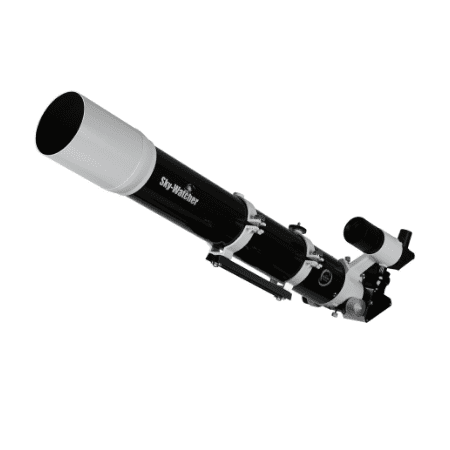
| BEST FOR Magnification |
|
| Type | Refractor |
|---|---|
| Item Weight | 29 pounds |
| Item Size | 41x 12x 15 inches |
| What You See | Moon, planetary bodies, cloud bands of Jupiter, star clusters, nebulae, distant galaxies. |
| Magnification | 45 X & 180 X |
| Aperture | 3.9 inches / 100 mm |
| Mount | V-style dovetail |
| Special Features | 20mm eyepiece, 5mm eyepiece, Dual speed Crawford type focuser, dielectric diagonal, aluminium carry case, 900mm focal length, f/9 focal ratio |
| Warranty | 2 years |
Why Choose the Sky-Watcher ProED 100 mm Telescope for Astrophotography?
This telescope offers the highest magnification power on our list. You will be able to capture beautifully detailed photographs of anything from our moon to distant galaxies. It has a 3.9-inch aperture, which doesn’t sound too amazing but combined with the fact that it is a refractor telescope with high-quality glass lenses, it offers sharper and crisper images than others with large apertures.
- 8×50 RA viewfinder makes it easy for you to find your way around and zoom in on your target.
- 2-inch dielectric diagonal makes for more comfortable viewing angle
- Crayford type focuser gives smooth adjustments
- 2 eyepieces offer 45x and 180x magnifications.
- It comes with a foam-lined aluminum case to protect the telescope while you travel.
- Uses Schott glass with anti-reflection coatings give low light dispersion and minimise distortion.
| Pros |
|---|
| Uses top quality glass and coatings to give clear views |
| High magnification levels allow you to capture detailed photos of deep space objects |
| Easy to pack away into carry case |
| Comes from one of the most extensive lines of ED-APOCHROMATIC refractors in the world |
| Cons |
|---|
| Pricey |
Verdict
The Sky-Watcher ProED 100mm is the best telescope for astrophotography if close-ups and high magnification interest you the most. The eyepieces and coated lenses give sharp imaging with minimal distortions. They will allow you to take high contrast photos of mountains and craters on the moon, cloud storms of Jupiter, and deep space nebulae. While pricey, it is an excellent investment in the long run.
3 Sky-Watcher ProED 80 mm APO Telescope for Astrophotography
Another model from the Sky-Watcher ProED line worth mentioning is their 80mm APO Refractor Telescope. This is a more affordable option that will still give you a professional-like experience. Just like the 100 mm above, it comes with the high-quality glass lenses and anti-reflection coatings for you to capture amazing details of the galaxy.
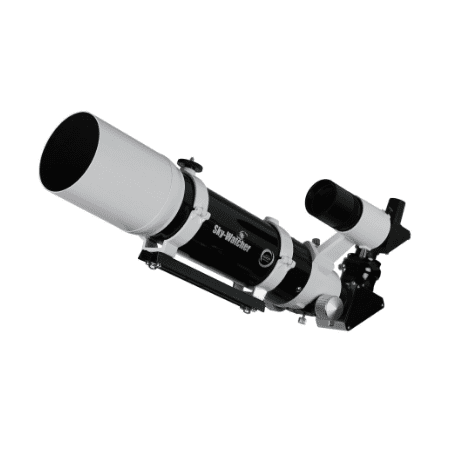
| BEST FOR Amateur Astrophotographers |
|
| Type | Refractor |
|---|---|
| Item Weight | 22 pounds |
| Item Size | 29 x 12 x 15 inches |
| What You See | Moon, planetary bodies, star clusters, nebulae, distant galaxies |
| Magnification | 30 X & 120 X |
| Aperture | 5 inches / 125 mm |
| Mount | Alt-Azimuth |
| Special features | 20mm eyepiece, 5mm eyepiece, dual speed Crawford type focuser, dielectric diagonal 8×50 RA erect-image finder scope, aluminum carry case, 600mm focal length, f/7.5 focal ratio. |
| Warranty | 2 years |
Why Choose the Sky-Watcher ProED 100 mm APO Astrophotography Telescope?
This is the best telescope for amateur astrophotographers. It will allow you to use a top of the range model with a low price tag. You still have all the features that allow you to take breathtaking photographs at a reasonable price.
- Quality lenses with anti-reflection coatings;
- 8×50 RA erect-image finder scope helps you navigate and focus;
- 2-inch dielectric diagonal for more comfortable viewings;
- 2 eyepiece sizes offering 30x and 120x magnification;
- Foam-lined carry case for protection.
| Pros |
|---|
| Great value for money |
| Coated lenses |
| High magnification |
| Cons |
|---|
| Some customers have found that the focuser can be stiff to manoeuvre |
Verdict
This telescope for astrophotography is great for those who are taking the step from hobbyist to amateur and taking it a little more seriously. It has good value for money, offering a high-quality experience with a smaller price tag.
4 Orion Astrograph Telescope
This telescope is designed to quickly and efficiently gather up light to provide high contrast photographs of deep space objects. The best thing about this telescope lies in its building. It does not need to rely on the inclusion of lots of added extras; its tech specs and features speak for themselves.
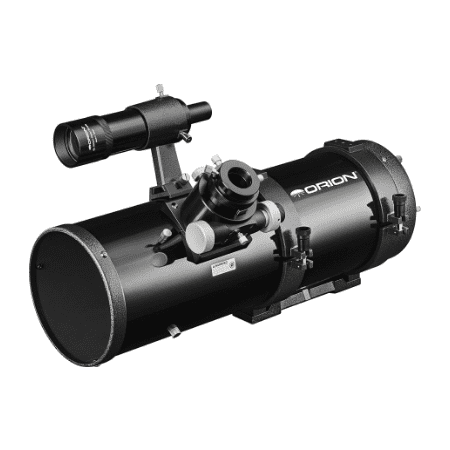
| BEST FOR Optic Speed |
|
| Type | Newtonian Reflector |
|---|---|
| Item Weight | 12.7 pounds |
| Item Size | 22.5 x 7 x 7 inches |
| What You See | Moon, planetary objects, star clusters |
| Magnification | Highest useful: 177 X |
| Aperture | 6 inches / 150 mm |
| Mount | Dovetail mounting bar |
| Special Features | 8×50 finder scope, dual speed Crayford focuser, dust caps, steel reinforcement plate, StarryNight Software, 610mm focal length, f/4.1 focal ratio |
| Warranty | 1 year |
Why Choose the Orion 6-inch f/4 Newtonian Astrograph Reflector Telescope?
This is the best telescope for astrophotography if you want an easy job of taking bright deep space pictures. The large 6-inch aperture and f/4 focal ratio allow the lenses to rapidly capture light. The optics create a large field of view to take in everything that the universe has to offer.
- Lenses are coated to increase reflectivity and the dual-speed Crayford focuser is positioned to eliminate unwanted beams of light.
- The unique steel reinforcement plate included in the design gives added stability, even when supporting a large camera.
- 8×50 Finderscope to help with deep space navigation.
- Comes with StarryNight Software access to help you plan ahead and learn as you go.
| Pros |
|---|
| It's compact and lightweight, meaning that it doesn’t need a large mount |
| Fast optic speed provides crisp, high definition photographs |
| Good price for the tech specs |
| Added stability |
| Cons |
|---|
| You need to purchase a mount separately |
Verdict
This model has been built with deep space astrophotography in mind. All the specs combine to provide stunningly sharp and high contrast images of the galaxy and other breath-taking space objects. It is one of the best telescopes for astrophotography if you want medium-ranged prices, excellent specs, durability, and versatility.
5 Orion SpaceProbe 130ST Equatorial Reflector Telescope for Astrophotography
This Orion SpaceProbe model is not only the best telescope for astrophotography when it comes to beginners and intermediates, but one of the best Orion telescopes on the market to date. We have discussed it on a previous occasion, so now we will just remind you of some of its most important tech specs and features.

| BEST FOR Beginner & Amateur Astrophotographers |
|
| Type | Newtonian reflector |
|---|---|
| Item Weight | 27 pounds |
| Item Size | 40 x 19 x 11 inches |
| What You See | Moon, planetary objects, star clusters, nebulae, galaxies |
| Magnification | 26 X & 65 X |
| Aperture | 5.1 inches / 130 mm |
| Mount | Equatorial |
| Special Features | 25mm eyepiece, 10mm eyepiece, 6×30 finder scope, tripod accessory tray, collimation cap, aluminium tripod, StarryNight software, equatorial mount with slow motion controls, 650mm focal length, f/5 focal ratio |
| Warranty | 1 year |
6 Gskyer Astronomical Refractor Telescope
If you like to approach your target from different angles you will need something lightweight and easy to move around. The Gskyer 600 x 900 mm AZ Astronomical Refractor Telescope is only 18 pounds and has no tool set up. Moreover, it is one of the best and most reliable telescopes for astrophotography on the market right now.
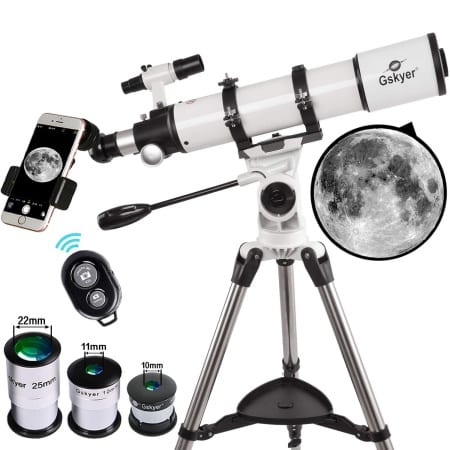
| BEST FOR Portability |
|
| Type | Refractor |
|---|---|
| Item Weight | 18 pounds |
| Item Size | 38 x 12 x 8 inches |
| What You See | Moon, planetary objects, star clusters |
| Magnification | 24 X, 60 X & 120 X |
| Aperture | 3.5 inches / 90 mm |
| Mount | Altazimuth |
| Special Features | 25mm eyepiece, 10mm eyepiece, 5mm eyepiece, 3X Barlow lens, erecting prism, 3×60 finder scope, aluminum tripod, 600mm focal length, f/6.7 focal ratio |
| Warranty | 1 year |
Why Choose the Gskyer Telescope for Astrophotography?
This is the best telescope for astrophotography if you are looking for something light-weight and portable. The Gskyger 600x900mm AZ Telescope is quick and simple to set up with no tools needed. The optics won’t disappoint you either, with specially designed anti-reflection components and coated glass lenses you can snap some amazing pictures.
- 3 eyepiece sizes offering 24x, 60x and 120x magnification
- 3x Barlow lens – tripling the magnification of each eyepiece, meaning that the 5mm eyepiece can now magnify 360x magnification.
- 48-degree erecting prism allows the telescope to be used for terrestrial targets.
- 3×60 Finderscope with crosshairs to help with navigation.
| Pros |
|---|
| Easy no-tool set up |
| Lightweight |
| You can upgrade it with accessories |
| You can also use it for terrestrial targets |
| Cons |
|---|
| The tripod can be a little tricky to balance |
Verdict
This telescope for astrophotography is a great option if you want something easier to set up or move around. It is very lightweight and easy to use. It makes a great choice for beginners too, as you can easily upgrade it to meet your needs. In conclusion, the Gskyer – a reputable brand in the market of telescopes and optical instruments – is a reliable and fun tool to use for your stargazing passion.
7 Celestron AstroMaster 130 EQ Telescope for Astrophotography
Another astrophotography telescope that is ideal for beginners is the Celestron AstroMaster 130 EQ Reflector telescope. This model comes with an equatorial mount to help you track sky objects. The telescope comes with a smartphone attachment for you to take pictures without having to invest in a separate camera.
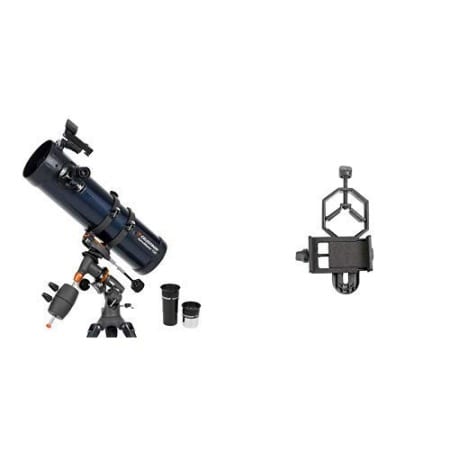
| BEST FOR Astrophotography learning |
|
| Type | Reflector |
|---|---|
| Item Weight | 28 pounds |
| Item Size | 35 x 19 x 12 inches |
| What You See | Moon, planets, Rings of Saturn, Jupiter’s moons, Andromedon galaxy, Pleiades Open Star Cluster |
| Magnification | 33 X & 65 X |
| Aperture | 5.11 inches / 130 mm |
| Mount | Equatorial |
| Special Features | Mounted finderscope, access to Starry Night software, adjustable steel tripod, erect image prism, two eye pieces, focal length 1000mm, f/11 focal ratio |
| Warranty | 2 years |
Why Choose the Celestron AstroMaster 130 EQ Reflector Telescope for Astrophotography?
This is one of the best telescopes for beginner astrophotographers. The equatorial mount comes with slow-motion controls and a rack and pinion focuser so that you can have seamless transitions and movements.
- Comes with two eyepieces – the 20mm has an image erector for terrestrial use and offers 33x magnification, and the 10mm offers 65x.
- 3x Barlow lens triples the eyepiece magnification, meaning that the 10mm now offers 195x.
- StarryNight educational software is included in the kit
- Glass lenses are coated for higher light transmission and clearer pictures.
| Pros |
|---|
| Comes with educational software |
| Easy no-tool set up |
| Equatorial tracking |
| Smartphone attachment |
| Cons |
|---|
| Tripod can be a little unstable |
Verdict
This product is a top choice for budding astrophotographers. It is very simple to set up with no tools needed, meaning you can focus on having fun instead of getting caught up with instructions. It will track your target so that it will never drift out of frame. With the smartphone adapter, you can take amazing photos with no need to buy an expensive camera.
8 Celestron Inspire Telescope for Astrophotography
The Celestron Inspire 100AZ comes packed with lots of added extras to get you going. If you are looking to upgrade your kit and try out a few new things you will love this model. As you know already, Celestron makes some of the best telescopes in the world, so you will not regret your choice.
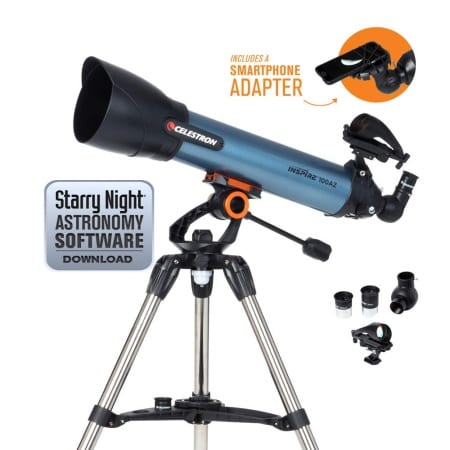
| BEST FOR Added Extras |
|
| Type | Refractor |
|---|---|
| Item Weight | 20 pounds |
| Item Size | 38 X 33 x 52 inches |
| What You See | Moon, planetary bodies, star clusters, Orion Nebula, Andromeda Galaxy |
| Magnification | 33 X & 66 X |
| Aperture | 3.9 inches / 100 mm |
| Mount | Altazimuth |
| Special Features | 20mm eyepiece, 10mm eyepiece, smartphone adapter, red LED flashlight, StarPointer finder scope, 90-degree erect image, steel tripod, accessory tray, 660mm focal length, f/5.6 focal ratio |
| Warranty | 2 years |
Why Choose the Celestron Inspire 100AZ Reflector Astrophotography Telescope?
Not only does the Celestron Inspire 100AZ telescope come packed with added extras, but it is also designed to give beautifully bright and sharp images. The 3.9-inch aperture, f/5.6 focal ratio, and fully coated lenses ensure that it can pick up every detail.
- 2 eyepieces which offer 33x & 66x magnification.
- The smartphone adapter will allow you to take pictures with almost any smartphone.
- The red LED flashlight will help you find your way without interfering with any night vision equipment and can even be stored away into the mount.
- StarPointer Pro finderscope will help you navigate and zoom in on your target.
- Educational Software includes the StarryNight software and access to the sky portal app.
- A 90-degree erect image allows the telescope to be used for terrestrial observations.
- Focus micrometre will help you return to targets if you are observing multiple objects at a time.
- Foldable accessory tray attached to the tripod gives easy access to all your tools and equipment.
| Pros |
|---|
| Excellent value for money |
| Light and portable |
| Easy no-tool set up |
| Packed with added extras |
| Cons |
|---|
| No slow-motion controls |
Verdict
If you are looking to get yourself fully kitted out with a lot of accessories as well as the telescope itself, you may want to check out the Celestron Inspire 100AZ. It comes with lots of gadgets to make it a fun experience and is suitable for users at any level. Moreover, you will fully enjoy the price and the hi-tech specs and features.
9 Celestron PowerSeeker 70EQ Telescope
The last entry on our best telescopes for astrophotography list is the Polaris 130 EQ. It is one of the most budget-friendly astrophotography telescopes on the market. It’s perfect if you want to get a good feel for exploring without investing in a high-end telescope, and still has many of the features that you would expect to find on more expensive models.
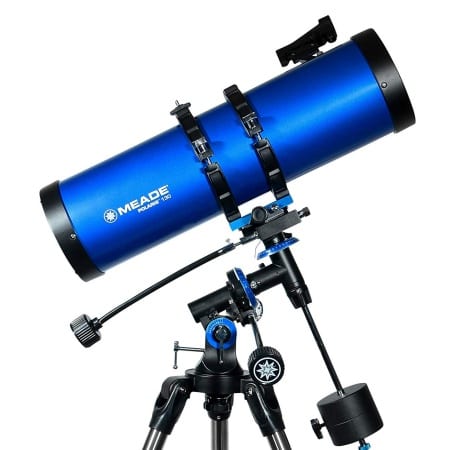
| BEST FOR Budget |
|
| Type | Reflector |
|---|---|
| Item Weight | 26.8 pounds |
| Item Size | 34 x 34 x 61.7 inches |
| What You See | Moon, planetary objects, star clusters, nebulae and galaxies |
| Magnification | 25 X, 72 X, & 103 X |
| Aperture | 5.1 inches / 130 mm |
| Mount | Equatorial |
| Special Features | 26mm, 9mm, & 6.3mm eyepieces, 2x Barlow lens, red dot finder scope, steel tripod, educational software & DVD, focal length 650mm, focal ratio f/5 |
| Warranty | 1 year |
Why Choose the Meade Instruments Polaris 130 EQ Reflector Telescope for Astrophotography?
This is a telescope that will allow you to get a real feel for astrophotography. Even though it is under $200, it still has all the features that will help you capture the perfect picture. Just like many of the more expensive models, it has an equatorial mount to keep your target centered while it drifts across the sky. It also has slow-motion controls for fine adjustments and smooth control. It can also attach most DSLR cameras without an adapter.
- 3 eyepieces provide 25x, 72x, and 103x magnification.
- The 2x Barlow lens will double the magnification of each eyepiece, giving a magnification of 206x using the 6.3mm eyepiece.
- 5-inch aperture captures lots of light to produce bright clear pictures.
- Everything is kept within reaching distance with the help of the accessory tray that accompanies the steel tripod.
- The red-dot finder scope will help you navigate your way and home in on your target.
- It also comes with an educational DVD and software to learn everything you need to know.
| Pros |
|---|
| Best budget telescope for astrophotography |
| Equatorial mount |
| Excellent magnification |
| Enthusiast customers' reviews |
| Cons |
|---|
| Many components made of plastic instead of metal |
Verdict
The Polaris 130 EQ is a top choice for those who want to try their hand at astrophotography while sticking to a budget. Although this is a more cost-effective way to enjoy your hobby, it doesn’t mean that the telescope is lacking any top features. It can still track your targets, has huge magnification power, and lots of added extras to make it easy to get started.
Buying the Best Telescope for Astrophotography: A Short Guide
Before you check out our best astrophotography telescopes, let us offer you some information you can factor in your purchase decision. We are sure that, by now, you are familiar with telescopes in general and understand how they work. When it comes to astrophotography telescopes, nevertheless, here are some points we have to make.
- Refractor telescopes use fixed glass lenses to focus light beams. This makes them more suited to beginners as there is no need to adjust the lenses.
- Reflector telescopes use mirrors to direct light. These can be a little more difficult to use, as the mirrors need to be collimated or adjusted. In other words, reflectors suit best the more confident or experienced users.
- It is best to opt for apochromatic lenses with the telescope. They have a better color correction to take a brighter picture with fewer distortions, but they are more expensive. Achromatic lenses are another option (more budget-friendly), but can still introduce small distortions.
- Mounting is another important factor to consider when choosing the right telescope for astrophotography. An equatorial mount is the best option, as it will keep your target in view as it drifts across the sky. EQ mounts often come with slow-motion controls, which allow you to make manual movements smoother and easier.
- Many of the telescopes on our list come with finderscopes. These are smaller lenses that allow you to step back and refocus your telescope at a different magnification. Such a feature lets you navigate the deep space much easier.
- Another important thing that may be easy to forget is how portable your telescope is. You don’t want to be bogged down by cumbersome equipment that is too difficult or heavy to transport. Naturally, the first thing to consider is the telescope’s size and weight, but also think about how much time and effort it takes to set up and pack away.
We hope you enjoyed our picks in the best telescope for astrophotography category. If you have more questions about optical instruments or different types of telescopes, feel free to ask! Happy stargazing and may your pictures be amazing!
Want more science now?
Check out our news page where we post interesting studies and discussions (sometimes mocking them mercilessly) for more.
